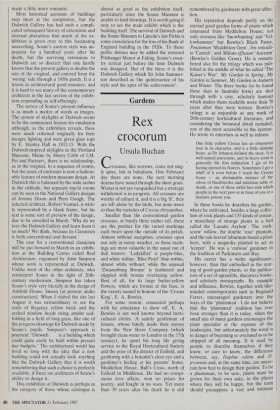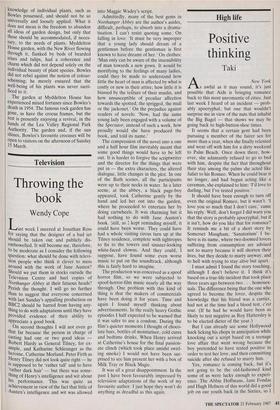Gardens
Rex crocorum
Ursula Buchan
Crocuses, like sorrows, come not sing- le spies, but in battalions. One February day there are none, the next morning dozens have nosed through the short grass. Winter is not yet vanquished but a strategic withdrawal is in progress. All crocuses are worthy of culture if, and it is a big 'if, they are left alone by the birds, but none more so than the varieties of Crocus chrysanthus.
Smaller than the conventional garden crocuses, at barely three inches tall, these are the prettier for the varied markings each bears upon the outside of its petals. Almost without exception, crocuses open out only in sunny weather, so these mark- ings are most valuable in the usual run of dull winters. `Ladykiller' is purple-blue, and white within; 'Blue Pearl' blue within, almost white without; while the unusual `Zwanenburg Bronze' is feathered and stippled with brodze overlaying yellow. Best of all, for its large butter-yellow flowers, which are bronze at the base, is the variety named in honour of the 'Crocus King', E. A. Bowles.
For some reason, connected perhaps with his reluctance to show off, E. A. Bowles is not well known beyond horti- cultural circles. A saintly gentleman of leisure, whose family made their money from the New River Company (which brought clean water to London in the 17th century), he spent his long life giving service to the Royal Horticultural Society and the poor of the district of Enfield, and gardening with a botanist's clear eye and a gardener's. feeling at his parents' home, Myddelton House, Bull's Cross, north of Enfield in Middlesex. He had no conspi- cuous love affairs, won no prizes for poetry, and fought in no wars. Yet more than 30 years after his death he is still remembered by gardeners with great affec- tion.
His reputation depends partly on the myriad good garden forms of plants which emanated from Myddelton House; not only crocuses like 'Snowbunting' and 'Yel- lowhammer' but Bowles's Black Pansy, Penstemon 'Myddelton Gem', Iris reticula- ta 'Cantab', and Milium effusum 'Aureum' (Bowles's Golden Grass). He is remem- bered also for the trilogy which was pub- lished in the middle of what he called 'The Kaiser's War': My Garden in Spring, My Garden in Summer, My Garden in Autumn and Winter. The three books (to be found these days in facsimile form) are shot through with a cosy, scholarly humour which makes them readable more than 70 years after they were written. Bowles's trilogy is as enjoyable as any work of 20th-century horticultural literature, and considering the botanical detail included, one of the most accessible to the layman. He wrote to entertain as well as inform: One little yellow Crocus has an obnoxious trait in its character, and is a little stinking beast, as Dr Johnson defined the stoat. It is well named graveolens, and its heavy scent is generally the first intimation I get of its having opened its flowers. Sometimes I get a whiff of it even before I reach the Crocus frame — an abominable mixture of the odour of blackbeetles and imitation sable or skunk, or one of those awful furs with which people in the next pew or in front of you at a matinee poison you.
In these books he describes his garden, where he cultivated, besides a large collec- tion of rock plants and 135 kinds of crocus, a miscellany of strange plants in a bed called the 'Lunatic Asylum'. The 'cork- screw' willow, the double 'rose' plantain, and the oak-leaved laburnum found a place here, with a magnolia planted to act as `keeper'. He was a 'curious' gardener in the tradition of Parkinson and Ray.
His career has a wider significance, however, than that embodied in the rear- ing of good garden plants, or the publica- tion of a set of agreeable, discursive books, and scholarly monographs. By example and influence, Bowles, together with like- minded contemporaries such as Reginald Farrer, encouraged gardeners into the ways of the 'plantsman'. I do not believe that the 'plantsman' tradition has ever been stronger than it is today, when the small size of many gardens encourages the plant specialist at the expense of the landscapist, but unfortunately the word is in danger of becoming so overused as to be stripped of all meaning. It is used by people to describe themselves if they know, or care to know, the difference between, say, Daphne odora and D. jezoensis and, at the same time, are uncer- tain how best to design their garden. To be a plantsman, to be sure, plants must be grown for their own sake, in the places where they will be happy, but the term should presuppose a vast and intimate knowledge of individual plants, such as Bowles possessed, and should not be so universally and loosely applied. What it does not mean is the freedom to abandon all ideas of garden design, but only that these should be accommodated, if neces- sary, to the needs of plants. Myddelton House garden, with the New River flowing through it, flanked by beds of bearded irises and tulips, had a coherence and charm which did not depend solely on the individual beauty of plant species. Bowles did not rebel against the notion of colour- scheming; he merely ensured that the well-being of his plants was never sacri- ficed to it.
The garden at Myddelton House has experienced mixed fortunes since Bowles's death in 1954. The famous rock garden has gone, as have the crocus frames, but the rest is presently enjoying a revival, in the hands of the Lea Valley Regional Park Authority. The garden and, if the sun shines, Bowles's favourite crocuses will be open to visitors on the afternoon of Sunday 15 March.



















































 Previous page
Previous page